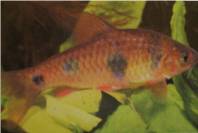Clown Barb
Genus name: Barbus Everetti
Also known as: Everett’s Barb
Distribution: Singapore and Borneo
Length: up to 6″ (15cm)
Minimum Tank Length: 36″ (90cm)
Water Temperature: 77-81F (25-27C)
Diet: Worms, crustaceans, plant matter, dried food, insects
Water: Fairly soft water
Lives: mostly in the lower areas of the aquarium
Breeding: Egg Layers
The Clown Barb is a hardy Asiatic Barb that has two pairs of barbels. The Clown Barb’s back is brownish or red-brown, sometimes with an orange tinge, and the abdomen is almost white. The flanks are reddish with golden or silvery iridescence and marked with somewhat irregular black or blue-grey vertical markings.
Unlike many of the other related species, the Clown Barb does not have a dark stripe running through the eye. The female Clown Barb is slightly larger and stouter than the male, and is also less colourful.
The Clown Barb is a lively barb which mainly lives in the lower layers of the aquarium, and it is best to keep a few together as they like to shoal. The aquarium should have marginal vegetation, but the plants should have tough leaves, as the Clown Barb is a leave nibbler.
The Clown Barb is not an easy fish to breed in captivity, although it can be done. Experience has shown that the best way to breed Clown Barbs is firstly to keep the prospective breeding fish apart for about three weeks. During this time give them a varied and plentiful diet of white worms, insect larvae, and greens such as lettuce.
When put back together, hopefully the Clown Barbs will spawn, and they do this generally in the sunshine on the early morning, and preferably among fine-leaved plants. As you would expect, the eggs and young of the Clown Barbs are not looked after, or safe from their parents.

